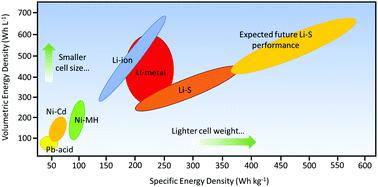当前位置:
X-MOL 学术
›
Nanoscale Horiz.
›
论文详情
Our official English website, www.x-mol.net, welcomes your feedback! (Note: you will need to create a separate account there.)
Nanoengineering to achieve high efficiency practical lithium-sulfur batteries.
Nanoscale Horizons ( IF 9.7 ) Pub Date : 2020-03-11 , DOI: 10.1039/c9nh00730j Eunho Cha 1 , Mumukshu Patel , Sanket Bhoyate , Vish Prasad , Wonbong Choi
Nanoscale Horizons ( IF 9.7 ) Pub Date : 2020-03-11 , DOI: 10.1039/c9nh00730j Eunho Cha 1 , Mumukshu Patel , Sanket Bhoyate , Vish Prasad , Wonbong Choi
Affiliation

|
Rapidly increasing markets for electric vehicles (EVs), energy storage for backup support systems and high-power portable electronics demand batteries with higher energy densities and longer cycle lives. Among the various electrochemical energy storage systems, lithium-sulfur (Li-S) batteries have the potential to become the next generation rechargeable batteries because of their high specific energy at low cost. However, the development of practical Li-S batteries for commercial products has been challenged by several obstacles, including unstable cycle life and low sulfur utilization. Only a few studies have considered the importance of low electrolyte and high sulfur loading to improve the overall energy densities of Li-S cells. This article reviews the recent developments of Li-S batteries that can meet the benchmarks of practical parameters and exceed the practical energy density of lithium-ion batteries (LIBs) including areal sulfur loading of at least 4 mg cm-2, electrolyte to sulfur ratio of less than 10 μL mg-1, and high cycling stability of over 300 cycles. This review presents the advancements in each component in Li-S batteries, including the enhancement of the electrochemical properties of sulfur cathodes, lithium anodes, or electrolytes. Also identified are several important strategies of nanoengineering and how they address the practical limitations of Li-S batteries to compete against LIBs. Additionally, perspectives on fundamentals, technology, and materials are provided for the development of Li-S batteries based on nanomaterials and nanoengineering so that they can enter the market of high energy density rechargeable storage systems.
中文翻译:

纳米工程实现了高效率的实用锂硫电池。
电动汽车(EV)的迅速增长的市场,用于备用支持系统的能量存储以及大功率便携式电子产品要求电池具有更高的能量密度和更长的使用寿命。在各种电化学储能系统中,锂硫(Li-S)电池因其高比能,低成本而具有成为下一代可再充电电池的潜力。然而,用于商业产品的实用Li-S电池的开发已经受到一些障碍的挑战,包括不稳定的循环寿命和低硫利用率。只有少数研究认为低电解质和高硫负荷对改善Li-S电池的整体能量密度的重要性。本文回顾了锂离子电池的最新发展,这些锂电池可以满足实际参数的基准并超过锂离子电池(LIB)的实际能量密度,包括面硫负荷至少4 mg cm-2,电解质与硫的比率小于10μLmg-1,并且超过300个循环的高循环稳定性。这篇综述介绍了锂硫电池中每个组件的进步,包括硫阴极,锂阳极或电解质的电化学性能的增强。还确定了纳米工程的几种重要策略,以及它们如何解决Li-S电池与LIB竞争的实际局限性。此外,有关基本面,技术,
更新日期:2020-02-19
中文翻译:

纳米工程实现了高效率的实用锂硫电池。
电动汽车(EV)的迅速增长的市场,用于备用支持系统的能量存储以及大功率便携式电子产品要求电池具有更高的能量密度和更长的使用寿命。在各种电化学储能系统中,锂硫(Li-S)电池因其高比能,低成本而具有成为下一代可再充电电池的潜力。然而,用于商业产品的实用Li-S电池的开发已经受到一些障碍的挑战,包括不稳定的循环寿命和低硫利用率。只有少数研究认为低电解质和高硫负荷对改善Li-S电池的整体能量密度的重要性。本文回顾了锂离子电池的最新发展,这些锂电池可以满足实际参数的基准并超过锂离子电池(LIB)的实际能量密度,包括面硫负荷至少4 mg cm-2,电解质与硫的比率小于10μLmg-1,并且超过300个循环的高循环稳定性。这篇综述介绍了锂硫电池中每个组件的进步,包括硫阴极,锂阳极或电解质的电化学性能的增强。还确定了纳米工程的几种重要策略,以及它们如何解决Li-S电池与LIB竞争的实际局限性。此外,有关基本面,技术,


























 京公网安备 11010802027423号
京公网安备 11010802027423号